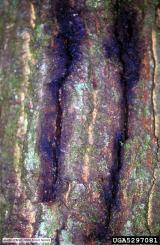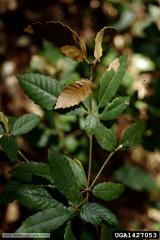Disease
Increasing mortality of coast live oak and tanoak was noted in rural and suburban areas around the San Francisco Bay area beginning about 1995. Public awareness and research attention grew rapidly, and the syndrome was named “sudden oak death,” but a causal agent was not proved until 2000, when a new Phytophthora species was isolated from stem cankers on dying trees (Rizzo et al. 2002). The California species proved to be identical to another unnamed Phytophthora detected in 1993 in Germany from declining rhododendron, and was ultimately named P. ramorum. Nurseries in California were first implicated as a disease source in 2001, and in 2003 it became evident that P. ramorum was in the nursery trade along the entire west coast of N. America, and was also widespread in European nurseries. Tree infections in Europe were limited to beech and non-native oak in southwest England and the Netherlands, often associated with infected rhododendrons. By 2009 the pathogen began to cause widespread damage to forest plantations of Japanese larch (“sudden larch death”) in the UK (Brasier & Webber 2010). International, national, and regional quarantines have been imposed to stop further spread of the pathogen. Efforts are focused on eradicating the pathogen from nurseries and containing the disease in forests. The pathogen is considered to have been introduced separately and relatively recently to both the US and Europe, although its native home is unknown (Mascheretti et al. 2008, Goss et al. 2009).
P. ramorum threatens the survival of tanoak in western parts of the tree’s range and is reducing populations of coast live oak dramatically. By 2014, between 30-45 million trees in California and Oregon were killed. The disease has also resulted in wildlife habitat loss, changes in ecosystem services, and increased fire risk in affected forests. While the NA1 clonal lineage of P. ramorum is most prevalent in California and Oregon forests, the EU1 clonal lineage has also been detected in Curry County, Oregon forests since 2015. There is grave concern that the EU1 lineage, generally shown to be more aggressive than the NA1 lineage in laboratory trials, poses a risk to Douglas-fir, a major timber species. Large areas of U.S. southeastern forests are also considered at risk for the disease (summarized in Kliejunas, 2010). An epidemic is occurring on Japanese larch in the UK where more than 10,000 ha of timber plantations have been affected (King et al. 2015). Heathlands, oak and beech forests, evergreen oak woodlands and laurel forests in Europe are also at risk (Sansford et al. 2009). P. ramorum spreads locally through rain splash of sporangia that form abundantly on the foliage of certain hosts, for example, California bay laurel, Japanese larch, Rhododendron ponticum, or on twigs of tanoak. Long distance aerial dispersal of sporangia is likely windborne (Hansen et al. 2008). Although the pathogen does not appear to infect roots, soilborne chlamydospores can survive long periods (Fichtner et al. 2009) and give rise to new sporangia that are splashed or carried to infect above-ground parts of plants. P. ramorum has also been baited from forest streams in California and Oregon and from waterways near several infested nurseries.
Symptoms differ on different host species. The pathogen causes sudden oak death (SOD), characterized by lethal stem cankers, on some Fagaceae (oaks), shoot dieback on some Ericaceae and conifers, and foliar blight on a diverse group of hosts. P. ramorum has an extremely broad host range that includes more than 150 species in 37 genera, although only a few forest species are highly susceptible. Many nursery hosts, such as rhododendron, camellia, and viburnum are important in long distance dispersal of the pathogen. P. ramorum is established in oak and tanoak forests in 15 coastal California counties, and in Curry County, Oregon, as well as in isolated forest estates in Europe. Timber plantations of Japanese larch in the UK are also infested.
The table of susceptible hosts below includes only the most ecologically and economically important host species. For a more complete list of the many other host species, download a pdf from APHIS (Animal and Plant Health Inspection Service of the U.S. Department of Agriculture) or FERA (Food and Environmental Research Agency of the U.K.). Our Disease Finder also includes more host species than this table.
| Host Latin Name | Host Common Name | Symptoms | Habitat | Region | |
|---|---|---|---|---|---|
| Fagus sylvatica | European Beech | Canker | Forest, Parklands | Germany, Netherlands, United Kingdom | |
| Larix kaempferi | Japanese larch | Canker, Dieback, Leaf necrosis | Plantations | Ireland, United Kingdom | |
| Notholithocarpus densiflorus | Tanoak | Blight, Canker | Forest | USA - California, Oregon | |
| Notholithocarpus densiflorus | Tanoak | Blight, Canker, Leaf necrosis, Twig canker | Forest | USA - California, Oregon | |
| Pseudotsuga menziesii | Douglas-fir | Dieback | Forest | USA - California | |
| Pseudotsuga menziesii | Douglas-fir | Dieback, Leaf necrosis, Twig canker | Forest | USA - California | |
| Quercus agrifolia | Coast live oak | Canker | Forest, Residential | USA - California | |
| Quercus chrysolepis | Canyon live oak, Oak | Canker | Forest | USA - California | |
| Quercus falcata | Oak, Southern red oak | Canker | Forest, Parklands | United Kingdom | |
| Quercus rubra | Northern red oak, Oak | Canker | Forest, Parklands | United Kingdom | |
| Rhododendron hybrids | Rhododendron hybrids | Blight, Dieback | Ornamental Nursery | Canada - British Columbia, Europe, USA | |
| Rhododendron macrophyllum | Pacific rhododendron | Blight, Dieback, Leaf necrosis, Twig canker | Forest | USA - California, Oregon | |
| Rhododendron ponticum | Pontic rhododendron | Blight, Dieback | Forest, Parklands | Ireland, United Kingdom | |
| Sequoia sempervirens | Coast redwood | Dieback | Forest | USA - California | |
| Umbellularia californica | California bay laurel, Myrtlewood | Blight, Leaf necrosis, Twig canker | Forest | USA - California | |
| Vaccinium ovatum | Evergreen huckleberry | Dieback, Leaf necrosis, Twig canker | Forest | USA - California, Oregon |




